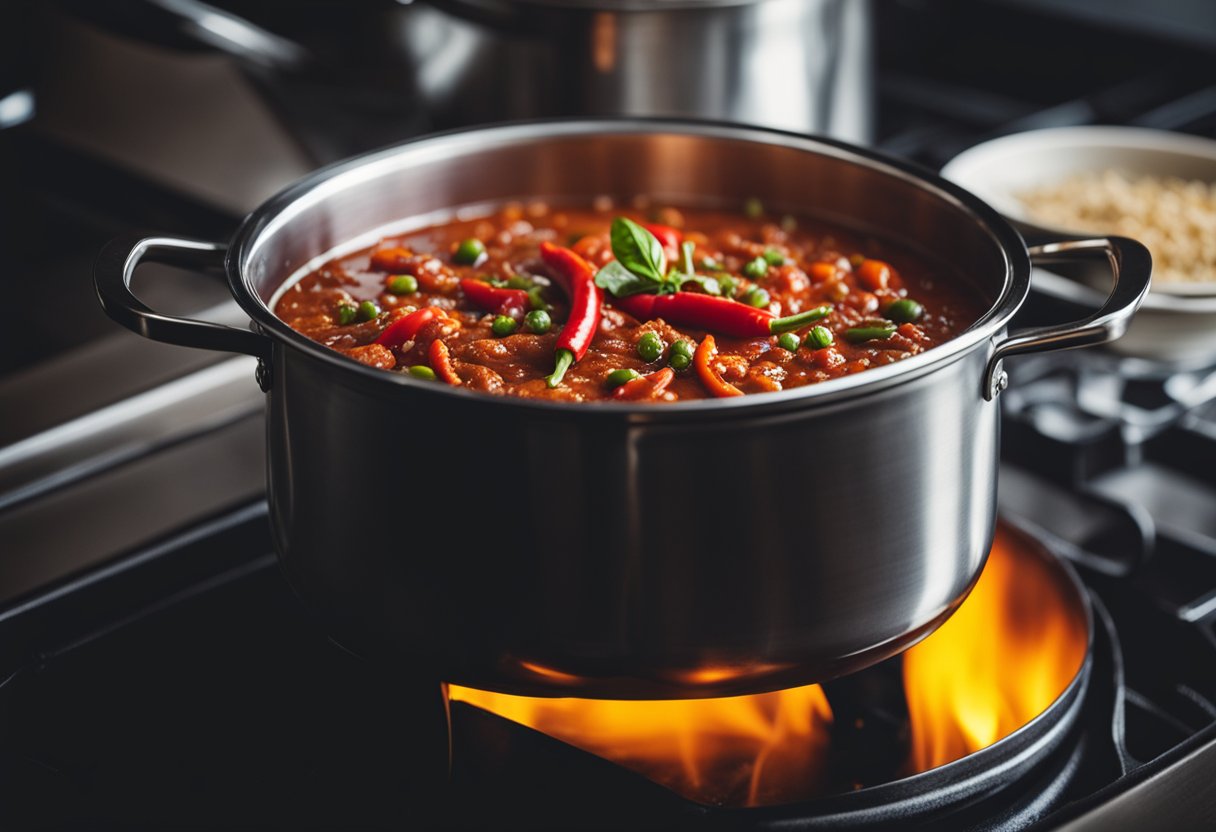As someone who loves chili, I know how frustrating it can be to have leftovers that go to waste. That’s why I’ve learned how to freeze chili, so I can enjoy it later without worrying about it spoiling.
Freezing chili is a simple and effective way to preserve this delicious dish, and it’s easy to do with just a few steps.

Understanding the basics of freezing chili is important before you begin. For example, it’s important to let the chili cool completely before freezing it, otherwise it can develop ice crystals and lose its texture.
Additionally, it’s important to store the chili in an airtight container or freezer bag to prevent freezer burn. By following these simple steps, you can ensure that your chili stays fresh and delicious for months to come.
Preparation before freezing is also key to ensuring your chili is frozen properly. You can choose to freeze chili in individual portions or in larger batches, depending on your needs.
You can also add additional ingredients like beans, corn, or vegetables to your chili before freezing to give it more flavor and texture.
By taking a few extra steps before freezing your chili, you can ensure that it tastes just as good when you reheat it later.
Key Takeaways
- Freezing chili is a simple and effective way to preserve this delicious dish.
- Let the chili cool completely before freezing it to prevent ice crystals from forming.
- Store the chili in an airtight container or freezer bag to prevent freezer burn.
Understanding the Basics of Freezing Chili
As someone who loves to cook, I often find myself making large batches of chili. However, I don’t always finish it all in one sitting.
That’s why I’ve learned how to freeze chili properly to save it for later. Here are some basics to keep in mind when it comes to freezing chili.
Does Chili Freeze Well?
The short answer is yes, chili freezes incredibly well. However, the texture and flavor of the chili can change slightly once it has been frozen and thawed.
This is especially true for creamy chilis, which can separate and become grainy. Tomato-based chili recipes tend to freeze the best, while beef chili and other ground meat chili also freeze well.
How Long Can You Freeze Chili?
Chili can be kept frozen for up to six months. However, for the best quality, it’s recommended to consume it within three months. After three months, the texture and flavor may start to deteriorate.
Freezing Method Explained
When it comes to freezing chili, there are a few methods you can use. Here’s a step-by-step guide to freezing your chili:
- Let the chili cool completely before freezing. If you try to freeze it while it’s still hot, it can cause freezer burn and affect the texture.
- Transfer the chili into an airtight, freezer-safe container or bag. If you’re using a container, leave some room at the top for the chili to expand as it freezes.
- Label the container or bag with the date and contents.
- Freeze the chili flat if possible. This will help it freeze faster and take up less space in your freezer. You can use freezer bags and lay them flat, then stack them once they’re frozen.
- To thaw the chili, place it in the fridge overnight. You can also thaw it in the microwave or on the stovetop, but be sure to stir it frequently to prevent it from burning.
By following these simple steps, you can freeze your chili and enjoy it later without sacrificing quality. Whether you’re meal prepping or just trying to save leftovers, freezing chili is a great option.
Preparation Before Freezing
Before freezing chili, it’s important to prepare it properly to ensure the best quality when reheated. Here are a few things to keep in mind:
Choosing the Right Chili
When it comes to freezing chili, not all recipes are created equal. Tomato-based chili recipes tend to freeze well, while creamy chili recipes may not freeze as well and can separate when reheated.
Beef chili and other ground meat chili recipes also tend to freeze well.
Ingredients to Avoid When Freezing
While most ingredients in chili can be frozen without issue, there are a few that may not hold up as well. For example, sour cream can separate when frozen and thawed, so it’s best to add it after reheating the chili.
Vegetables like onions and peppers can also become mushy when frozen, so consider leaving them out or using frozen vegetables instead.
Additionally, homemade chili seasoning may lose its potency over time, so consider adding extra seasoning when reheating the chili.
When it comes to beans, kidney beans and pinto beans can be frozen without issue, but they may become slightly softer when reheated.
If you prefer firmer beans, consider leaving them out and adding them after reheating the chili.
By keeping these tips in mind, you can ensure that your chili freezes and reheats as well as possible. In the next section, we’ll discuss the best containers to use for freezing chili.
Freezing Process
When it comes to freezing chili, there are a few things to keep in mind. In this section, I will outline the steps you need to take to freeze your chili properly.
Using Freezer-Safe Containers
When freezing chili, it is important to use freezer-safe containers. These containers are designed to withstand the extreme temperatures of the freezer without cracking or breaking.
You can use airtight containers, freezer-safe bags, or any other container that is specifically labeled as safe for the freezer.
If you choose to use freezer-safe bags, make sure to remove as much air as possible before sealing the bag. This will help prevent freezer burn and keep your chili fresh for longer.
Storing Chili in the Freezer
Once you have your freezer-safe container ready, it’s time to store your chili in the freezer. Make sure to label and date your container so that you know when it was frozen.
Chili can be stored in the freezer for up to 6 months. To defrost your chili, simply transfer it to the refrigerator and let it thaw overnight. Alternatively, you can defrost it in the microwave or on the stovetop.
When storing chili in the freezer, it is important to keep it in an airtight container to prevent freezer burn and maintain its flavor. You can also store chili in portion-sized containers, so you can easily defrost only what you need.
Overall, freezing chili is a great way to save time and reduce food waste. By following these simple steps, you can ensure that your chili stays fresh and delicious for months to come.
Defrosting and Reheating Chili
When it comes to defrosting and reheating chili, there are a few things to keep in mind to ensure that your chili is safe to eat and tastes as delicious as the day you made it.
In this section, I will cover how to defrost chili and how to reheat it, so you can enjoy your frozen chili without any worries.
How to Defrost Chili
The best way to defrost chili is to place it in the refrigerator and let it thaw slowly. This is the safest method because it prevents the growth of bacteria that can cause foodborne illnesses.
Depending on the amount of chili you have, it may take several hours or even overnight to thaw completely. Once thawed, you can reheat the chili using your preferred method.
If you’re short on time, you can also defrost chili in the microwave. To do this, transfer the chili to a microwave-safe dish and use the defrost setting on your microwave.
Be sure to stir the chili every few minutes to ensure even defrosting. Keep in mind that this method may cause the chili to lose some of its texture and flavor.
Another option is to defrost chili using cold water. This method is faster than defrosting in the refrigerator but requires more attention.
To do this, place the chili in a leak-proof plastic bag and submerge it in a bowl of cold water. Change the water every 30 minutes until the chili is thawed. Be sure to cook the chili immediately after defrosting using this method.
Reheating Chili
Once your chili is thawed, it’s time to reheat it. The best way to reheat chili is on the stove, as it allows for even heating and helps to preserve the texture and flavor of the chili.
To do this, transfer the chili to a pot and heat it over medium-low heat, stirring occasionally, until it reaches the desired temperature.
If you’re short on time, you can also reheat chili in the microwave. To do this, transfer the chili to a microwave-safe dish and heat it on high for 1-2 minutes, stirring every 30 seconds to ensure even heating.
Keep in mind that this method may cause the chili to lose some of its texture and flavor.
It’s important to note that once chili has been thawed, it should not be refrozen. If you have leftover chili after reheating, store it in the refrigerator and consume it within 3-4 days.
In summary, defrosting and reheating chili is a simple process that requires a bit of patience and attention to detail. By following these tips, you can safely and deliciously enjoy your frozen chili.
Tips and Tricks for Freezing Chili
When it comes to freezing chili, there are a few tips and tricks that can help you preserve the flavor and texture of your favorite dish. Here are some things to keep in mind:
Avoiding Freezer Burn
Freezer burn is a common problem when it comes to freezing food, including chili. It occurs when moisture in the food evaporates and then re-freezes on the surface of the food, creating a dry, leathery texture and a loss of flavor.
To avoid freezer burn, make sure your chili is completely cool before freezing it. You can also use airtight containers or freezer bags and remove as much air as possible before freezing.
Label and date your chili so you can keep track of how long it’s been in the freezer.
Can You Refreeze Chili?
It’s generally safe to refreeze chili if it has been thawed properly in the refrigerator. However, it’s important to note that each time you freeze and thaw food, you risk losing some of the quality and flavor.
To minimize this risk, try to freeze your chili in portion sizes that you can use up in one go. If you have leftovers, you can freeze them again, but keep in mind that the texture and flavor may not be as good as the first time around.
Making Large Batches
If you’re making a large batch of chili for meal prep or to store for later, there are a few things you can do to make the process easier.
First, consider using a slow cooker or a large pot to make the chili in one go. This will save you time and effort. Next, divide the chili into portion sizes that work for you.
You can use freezer bags or airtight containers for this. Be sure to label and date each portion so you know what’s in it and when it was frozen.
Freezing chili is a great way to save time and money on meal prep, but it’s important to do it right to ensure the best quality and flavor.
By following these tips and tricks, you can freeze your chili with confidence and enjoy it whenever you want.
Freezer Chili Recipe
I love making chili in my slow cooker, but sometimes I end up with more than I can eat. That’s why I always freeze some for later.
Freezing chili is a great way to have a quick and easy meal on hand when you’re short on time. Here’s my go-to freezer chili recipe:
Ingredients
- 1 pound ground pork
- 1 can black beans, drained and rinsed
- 1 can kidney beans, drained and rinsed
- 1 can diced tomatoes
- 1 can tomato sauce
- 1 onion, chopped
- 2 cloves garlic, minced
- 2 tablespoons chili powder
- 1 tablespoon cumin
- 1 teaspoon paprika
- Salt and pepper to taste
- Shredded cheese (optional)
Instructions
- Brown the pork in a large skillet over medium-high heat.
- Add the onion and garlic and cook until softened.
- Add the chili powder, cumin, paprika, salt, and pepper and cook for another minute.
- Add the diced tomatoes, tomato sauce, and beans and bring to a simmer.
- Let simmer for 20-30 minutes, until the flavors have melded together.
- Let cool to room temperature.
- Divide into individual portions and freeze in airtight containers or freezer bags.
- When ready to eat, thaw in the refrigerator overnight and reheat on the stove or in the microwave.
- Top with shredded cheese if desired.
This recipe makes a large batch, so it’s perfect for freezing. You can also customize it to your liking by adding more or less spice, using different types of beans, or even adding in some vegetables like bell peppers or corn.
I like to freeze my chili in individual portions so I can easily grab one for a quick lunch or dinner. It’s also a great way to prevent waste – you can thaw and reheat only what you need.
Overall, this freezer chili recipe is a great way to have a delicious and nutritious meal on hand whenever you need it.
Related posts:
Frequently Asked Questions

Can you freeze chili with kidney beans?
Yes, you can freeze chili with kidney beans. However, it is important to note that the texture of the beans may change slightly after freezing and thawing.
To minimize this, it is recommended to slightly undercook the beans before adding them to the chili. Additionally, it is important to cool the chili completely before freezing it to prevent the beans from becoming mushy.
How to freeze chili without freezer burn?
Freezer burn occurs when moisture in the food evaporates and creates ice crystals on the surface. To prevent freezer burn when freezing chili, it is important to use airtight containers or freezer bags.
Remove as much air as possible before sealing the container or bag. It is also recommended to use containers that are the appropriate size for the amount of chili being frozen to minimize the amount of air inside the container.
Can you freeze chili with meat and beans?
Yes, you can freeze chili with meat and beans. However, it is important to note that the texture of the meat and beans may change slightly after freezing and thawing.
To minimize this, it is recommended to slightly undercook the meat and beans before adding them to the chili. Additionally, it is important to cool the chili completely before freezing it to prevent the meat and beans from becoming mushy.
Can you freeze chili in glass containers?
Yes, you can freeze chili in glass containers. However, it is important to use containers that are specifically designed for freezer use.
Regular glass containers may crack or shatter due to the extreme temperature changes that occur during freezing and thawing.
How to reheat frozen chili?
To reheat frozen chili, it is recommended to thaw it in the refrigerator overnight. Once thawed, transfer the chili to a pot and heat it over medium heat until it is heated through.
Alternatively, you can reheat the chili in the microwave by placing it in a microwave-safe dish and heating it in 1-minute intervals until it is heated through.
What is the best container to freeze chili in?
The best container to freeze chili in is an airtight freezer-safe container or freezer bag. It is important to choose a container that is the appropriate size for the amount of chili being frozen to minimize the amount of air inside the container.
Additionally, it is important to label the container or bag with the date and contents to make it easier to identify later.







